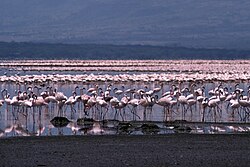Lake Bogoria
| Lake Bogoria | |
|---|---|

Flamingos nesting on the shoreline of the lake
|
|
| Coordinates | 0°15′N 36°06′E / 0.250°N 36.100°ECoordinates: 0°15′N 36°06′E / 0.250°N 36.100°E |
| Lake type | saline, alkaline, meromictic |
| Primary inflows | Sandai and Emsos rivers, springs |
| Catchment area | 700 km2 (270 sq mi) |
| Basin countries | Kenya |
| Max. length | 34 km (21 mi) |
| Max. width | 3.5 km (2.2 mi) |
| Surface elevation | 990 m (3,250 ft) |
Lake Bogoria is a saline, alkaline lake that lies in a volcanic region in a half-graben basin south of Lake Baringo, Kenya, a little south of the equator. Lake Bogoria, like Lake Nakuru, Lake Elmenteita, and Lake Magadi further south in the Rift Valley, and Lake Logipi to the north, is home at times to one of the world's largest populations of lesser flamingos. The lake is a Ramsar site and Lake Bogoria National Reserve has been a protected National Reserve since November 29, 1973. Lake Bogoria is shallow (about 10 m depth), and is about 34 km long by 3.5 km wide, with a drainage basin of [[1 E8 m2|700 km2]].
Local features include the Kesubo Swamp to the north and the Siracho Escarpment to the east, both within the National Reserve. The lake is also famous for geysers and hot springs along the bank of the lake and in the lake. In four locations around the lake can be observed at least 10 geysers, which erupt up to 5 m high. Geyser activity is affected by the fluctuations of lake level, which may inundate or expose some geysers.
The lake waters contain large concentrations of Na+, HCO3− and CO32− ions. They originate from inflow from the Sandai and Emsos rivers, and from about 200 alkaline hot springs that are present at three onshore sites: Loburu, Chemurkeu, and a southern group (Ng'wasis, Koibobei, Losaramat). Other springs discharge directly from the lake floor. Lake Bogoria also contains the highest concentration of true geysers in Africa (at least 18 are known). The lake waters are alkaline (pH:10.5) and saline (up to 100 g/L total dissolved salts). The lake has no surface outlet so the water becomes saline mainly through evaporation, which is high in this semi-arid region. The lake itself is meromictic (stratified) with less dense surface waters lying on a denser more saline bottom waters. Although hypersaline, the lake is highly productive with abundant cyanobacteria (Arthrospira fusiformis) that feed the flamingoes, but few other organisms inhabit the lake e.g. the monogonont rotifer species Brachionus sp. Austria (belonging to the Brachionus plicatilis cryptic species complex) is found in high densities.
...
Wikipedia
